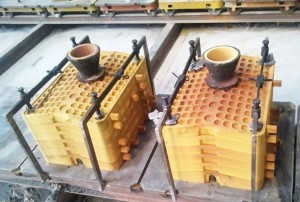

Shell molding, also known as shell-mold casting,[1] is an expendable mold casting process that uses resin covered sand to form the mold. As compared to sand casting, this process has better dimensional accuracy, a higher productivity rate, and lower labour requirements. It is used for small to medium parts that require high precision.[2] Shell moulding was developed as a manufacturing process during the mid-20th century in Germany. It was invented by German engineer Johannes Croning.[3][4] Shell mould casting is a metal casting process similar to sand casting, in that molten metal is poured into an expendable mould. However, in shell mould casting, the mould is a thin-walled shell created from applying a sand-resin mixture around a pattern. The pattern, a metal piece in the shape of the desired part, is reused to form multiple shell moulds. A reusable pattern allows for higher production rates, while the disposable moulds enable complex geometries to be cast. Shell mould casting requires the use of a metal pattern, oven, sand-resin mixture, dump box, and molten metal.
Shell mould casting allows the use of both ferrous and non-ferrous metals, most commonly using cast iron, carbon steel, alloy steel, stainless steel, aluminium alloys, and copper alloys. Typical parts are small-to-medium in size and require high accuracy, such as gear housings, cylinder heads, connecting rods, and lever arms.
The shell mould casting process consists of the following steps:
Pattern creation - A two-piece metal pattern is created in the shape of the desired part, typically from iron or steel. Other materials are sometimes used, such as aluminium for low volume production or graphite for casting reactive materials.
Mold creation - First, each pattern half is heated to 175-370 °C (350-700 °F) and coated with a lubricant to facilitate removal. Next, the heated pattern is clamped to a dump box, which contains a mixture of sand and a resin binder. The dump box is inverted, allowing this sand-resin mixture to coat the pattern. The heated pattern partially cures the mixture, which now forms a shell around the pattern. Each pattern half and surrounding shell is cured to completion in an oven and then the shell is ejected from the pattern.
Mould assembly - The two shell halves are joined together and securely clamped to form the complete shell mould. If any cores are required, they are inserted prior to closing the mould. The shell mould is then placed into a flask and supported by a backing material.
Pouring - The mould is securely clamped together while the molten metal is poured from a ladle into the gating system and fills the mould cavity.
Cooling - After the mould has been filled, the molten metal is allowed to cool and solidify into the shape of the final casting.
Casting removal - After the molten metal has cooled, the mould can be broken and the casting removed. Trimming and cleaning processes are required to remove any excess metal from the feed system and any sand from the mould.
Examples of shell moulded items include gear housings, cylinder heads and connecting rods. It is also used to make high-precision molding cores.
Process:
The process of creating a shell mold consists of six steps:[2][5]
Fine silica sand that is covered in a thin (3–6%) thermosetting phenolic resin and liquid catalyst is dumped, blown, or shot onto a hot pattern. The pattern is usually made from cast iron and is heated to 230 to 260 °C (450 to 600 °F). The sand is allowed to sit on the pattern for a few minutes to allow the sand to partially cure.
The pattern and sand are then inverted so the excess sand drops free of the pattern, leaving just the "shell". Depending on the time and temperature of the pattern the thickness of the shell is 10 to 20 mm (0.4 to 0.8 in).
The pattern and shell together are placed in an oven to finish curing the sand. The shell now has a tensile strength of 350 to 450 psi (2.4 to 3.1 MPa).
The hardened shell is then stripped from the pattern.
Two or more shells are then combined, via clamping or gluing using a thermoset adhesive, to form a mold. This finished mold can then be used immediately or stored almost indefinitely.
For casting the shell mold is placed inside a flask and surrounded with shot, sand, or gravel to reinforce the shell.[6][7]
The machine that is used for this process is called a shell molding machine. It heats the pattern, applies the sand mixture, and bakes the shell.
Notes
1 Degarmo 2003, p. 310.
2 Degarmo 2003, p. 308.
3Recknagel, Ulrich. "The Shell Moulding Process: A German Innovation" (PDF). Huettenes-albertus: 1/7.
4Recknagel, Ulrich (2008). "GIESSEREI Rundschau" (PDF). Fachzeitschrift der Österreichischen Giesserei-Vereinigungen: 17/36.
5 Degarmo 2003, p. 309.
6 Todd, Allen & Alting 1994, p. 267.
7 "Prime mold removal". Wednesday, 12 December 2018
Post time: Aug-17-2021

